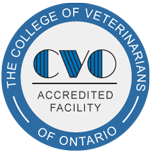Illustrated Articles
-
Gastrointestinal endoscopy uses a flexible tube with a camera or viewing port to inspect the esophagus, stomach, proximal small intestine, or colon for evidence of disease-causing clinical signs characteristic of gastrointestinal disease. Foreign bodies can often be retrieved. Biopsies are taken of abnormal and normal tissue, as not all conditions cause gross changes to the stomach or intestinal surface. The endoscope cannot reach all areas of the small intestine, so other tests may be needed to diagnose disease in this area. Endoscopic pinch biopsies are not full thickness so if diagnosis is not achieved with endoscopic biopsies, additional testing including surgical biopsies may be needed. 12-18 hours fasting and enemas are required prior to endoscopy depending on the area being studied.
-
Gastrointestinal endoscopy uses a flexible tube with a camera or viewing port to inspect the esophagus, stomach, proximal small intestine, or colon for evidence of disease-causing clinical signs characteristic of gastrointestinal disease. Foreign bodies can often be retrieved. Biopsies are taken of abnormal and normal tissue, as not all conditions cause gross changes to the stomach or intestinal surface. The endoscope cannot reach all areas of the small intestine, so other tests may be needed to diagnose disease in these areas. Endoscopic pinch biopsies are not full thickness so if diagnosis is not achieved with endoscopic biopsies, additional testing including surgical biopsies may be needed. 12-18 hours fasting and enemas are required prior to endoscopy depending on the area being studied.
-
A gastropexy is a surgical procedure that is sometimes performed in large-breed dogs to prevent gastric dilatation and volvulus (GDV), also known as bloat – a life-threatening condition. This handout explains how the procedure works, how it is used preventatively and in emergency situations, risk factors, and post-operative care.
-
Gastrostomy tubes are placed percutaneously through the skin directly into the stomach and may be needed for cats who are unable to chew or swallow their food, or for cats with diseases causing anorexia. Special liquid diets or canned diets blended with water are recommended to be given in multiple feedings throughout the day, dependent on the cat’s reason for the tube. Instructions are provided by your veterinarian for tube feeding and tube maintenance. The tube can be removed as early as 14 days after placement once the cat is eating well. Your veterinarian will remove the tube.
-
Gastrostomy tubes are placed through the skin of the abdomen into the stomach to enable long-term nutrition in dogs that either refuse to eat or are unable to chew and swallow food. A special liquid diet or homemade mixture liquefied with water will be recommended by your veterinarian. Step-by-step instructions are provided. The decision to remove the tube will be determined by your veterinarian.
-
Genetic (DNA) testing is readily available, whether you are using it for fun to find out what breeds your pet is made up of or if you are looking into possible medical conditions. DNA samples can be collected either from a cheek swab or a blood draw. Knowing which breeds your pet is made up of can help you and your veterinarian prevent or prepare for health issues in the future.
-
Deoxyribonucleic acid (DNA) is a long molecule that contains an animal’s entire genetic code. DNA is primarily located within the nucleus of each cell. In the nucleus, enzymes transcribe the DNA bases into a substance called RNA (ribonucleic acid), which serves as a messenger, taking the DNA message out into the cytoplasm of the cell where the RNA is translated into proteins. These proteins are responsible for a number of functions in the cell and throughout the body, primarily by acting as enzymes that regulate various cell reactions. DNA tests allow us to examine an animal’s DNA in order to see whether they carry certain genetic diseases. DNA testing can also be used to determine the ancestry of an animal.
-
This is a lively dog with a playful personality that demands to be with people and in the thick of things—and isn't above a bit of high-energy mischief.
-
Shepherds are intelligent and can learn almost any task. They have big hearts and often attempt to perform a request even if it's beyond their physical ability.
-
Easy care in the grooming department, they are high maintenance mentally, demanding a lot of attention and daily play or work time. They are not fussy as to which, as long as it involves exercise and their favorite person.


